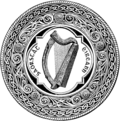| Monarchy of the Irish Free State | |
|---|---|
 | |
| Details | |
| Style | His Majesty |
| First monarch | George V |
| Last monarch | George VI |
| Formation | 6 December 1922 |
| Abolition | 29 December 1937 |
| Residence | Viceregal Lodge |
The state known today as Ireland is the successor state to the Irish Free State, which existed from December 1922 to December 1937. At its foundation, the Irish Free State was, in accordance with its constitution and the terms of the Anglo-Irish Treaty, governed as a constitutional monarchy, in personal union with the monarchy of the United Kingdom and other members of what was then called the British Commonwealth. The monarch as head of state was represented in the Irish Free State by his Governor-General, who performed most of the monarch's duties based on the advice of elected Irish officials.
The Statute of Westminster, passed in 1931, granted expanded sovereignty to the Dominions of the British Commonwealth, and permitted the Irish state to amend its constitution and legislate outside the terms of the Treaty. The Executive Authority (External Relations) Act 1936, enacted in response to the abdication of Edward VIII, removed the role of the monarch for all internal purposes, leaving him only a few formal duties in foreign relations as a "symbol of cooperation" with other Commonwealth nations. The Constitution of Ireland, which took effect in December 1937, established the position of president of Ireland, with the office first filled in June 1938, but the monarch retained his role in foreign affairs, leaving open the question of which of the two figures was the formal head of state. The Republic of Ireland Act 1948 ended the statutory position of the British monarch for external purposes and assigned those duties to the President, taking effect in April 1949, from which point Ireland was inarguably a republic.